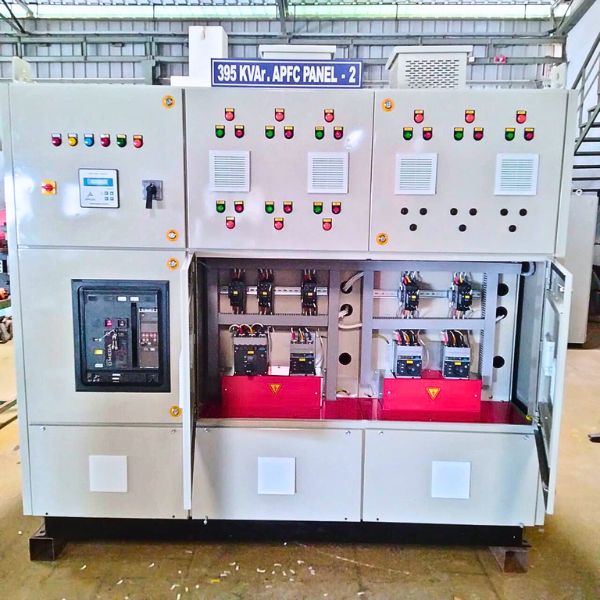News & Events
Advancements in APFC Panels: A Key Solution Manufactured by Everrise Engineering

- Real-Time Power Monitoring: Continuous monitoring ensures peak efficiency.
- Modular Design: Our panels allow easy expansion as your needs grow.
- Harmonic Filtering: Cleaner and more stable power protects equipment.
- IoT Integration: Monitor and maintain system health with predictive analytics.
Why APFC Panels Are Essential
Installing APFC panels is a necessity for today’s businesses, reducing demand charges and enhancing equipment lifespan. Everrise Enginering’s APFC panels ensure energy efficiency, regulatory compliance, and long-term savings.
Real-World Savings
Consider an industry with a power factor of 0.7, consuming 500 kW. The apparent power is:
S = P / PF = 500 / 0.7 = 714.29 kVAImproving the power factor to 0.95 with an APFC panel reduces the apparent power:
Snew = 500 / 0.95 = 526.32 kVAThis reduction leads to significant savings in demand charges and demonstrates commitment to efficient energy use.
Why Choose Everrise Engineering?
Everrise Engineering provides certified APFC panels that meet global standards. Our solutions are customized, scalable, and supported long after installation.
- ISO-certified manufacturing: Built to last with reliable standards.
- Tailored Solutions: Panels designed to optimize your power usage.
- Ongoing Support: We offer maintenance to ensure continued efficiency.
Get in Touch
If your business faces power inefficiencies or high demand charges, it’s time to consider APFC panels from Everrise Enginering. Contact us today for a consultation, and take the first step toward energy savings and regulatory compliance.
'>Advancements in APFC Panels: A Key Solution Manufactured by Everrise Engineering
At Everrise Engineering, we are committed to providing cutting-edge solutions for industrial energy efficiency. We specialize in the manufacture of Automatic Power Factor Correction (APFC) panels, designed to meet modern business needs. Our APFC panels ensure compliance with industry standards and provide long-term cost savings.
In this article, we explore the significance of APFC panels, who needs them, and why they are critical for industries today.
Why Power Factor Matters in Industrial Settings
Power factor measures how efficiently electrical systems use the supplied power. Industries with motors, transformers, and inductive loads often have a low power factor, leading to:
- Higher electricity bills.
- Strain on infrastructure.
- Potential penalties from utilities.
APFC panels automatically correct the power factor, enhancing efficiency and reducing costs.
Why Industries Need APFC Panels
Industries with fluctuating electrical loads or heavy machinery benefit most from APFC panels. This includes:
- Manufacturing Plants: Motors and transformers cause significant current lag.
- Commercial Buildings: HVAC systems and elevators increase power usage.
- Textile and Automotive Industries: These industries rely heavily on electrical loads.
- Hospitals and Educational Institutions: Reliable power management is crucial.
Everrise Engineering: Leaders in APFC Panels
At Everrise Engineering, our custom APFC panels are designed for your specific needs. Here's why they stand out:
- Real-Time Power Monitoring: Continuous monitoring ensures peak efficiency.
- Modular Design: Our panels allow easy expansion as your needs grow.
- Harmonic Filtering: Cleaner and more stable power protects equipment.
- IoT Integration: Monitor and maintain system health with predictive analytics.
Why APFC Panels Are Essential
Installing APFC panels is a necessity for today’s businesses, reducing demand charges and enhancing equipment lifespan. Everrise Enginering’s APFC panels ensure energy efficiency, regulatory compliance, and long-term savings.
Real-World Savings
Consider an industry with a power factor of 0.7, consuming 500 kW. The apparent power is:
S = P / PF = 500 / 0.7 = 714.29 kVAImproving the power factor to 0.95 with an APFC panel reduces the apparent power:
Snew = 500 / 0.95 = 526.32 kVAThis reduction leads to significant savings in demand charges and demonstra


